To draw like a pro, understanding the math behind perspective is key. You’ll focus on vanishing points, which guide how lines recede into space, and foreshortening, which creates depth by compressing or stretching objects. Precise placement of vanishing points and accurate line alignment guarantee your work looks realistic and convincing. Mastering these concepts builds confidence and improves your skills. Keep exploring, and you’ll discover more techniques for creating immersive, professional-looking art.
Key Takeaways
- Understand the role of vanishing points and horizon lines to accurately depict depth and spatial relationships.
- Apply geometric principles and basic equations to construct consistent perspective grids and receding lines.
- Use foreshortening techniques to represent objects and limbs realistically in three-dimensional space.
- Practice precise measurement and line convergence to improve vanishing point accuracy.
- Study the mathematical foundation behind perspective to enhance control and realism in your drawings.

Ever wondered how some artists make their drawings look effortless and professional? The secret often lies in mastering perspective drawing, a skill rooted in understanding the mathematics behind how we perceive space. When you focus on foreshortening techniques, you learn to depict objects and figures that appear to recede or project into space, creating a sense of depth and realism. Foreshortening challenges artists to capture the natural distortion that occurs when an object is viewed from a specific angle, and with practice, you can make these distortions look convincing. The key is understanding how to compress or stretch parts of your subject to match the viewer’s perspective, which involves a keen sense of proportion and spatial judgment.
Alongside foreshortening, vanishing point accuracy plays an essential role in achieving realistic perspective. The vanishing point is where parallel lines seem to converge on the horizon, and understanding its placement helps you anchor your drawings in a believable space. When you correctly identify the vanishing point, it guides the way you draw lines that recede into the distance, ensuring they stay consistent across your composition. Precise vanishing point placement prevents your scene from looking distorted or unnatural, giving your artwork a professional polish. It’s like setting a foundation—once you get the vanishing point right, everything else naturally falls into place.
Accurate vanishing points anchor your drawings in realistic space, ensuring consistent, polished perspectives.
To master these elements, you should start by establishing your horizon line and vanishing point early in your sketch. This helps you maintain accuracy as you draw structures, figures, or objects within the scene. When you’re sketching a figure in perspective, for example, use foreshortening techniques to depict limbs or torsos that seem to come forward or recede. Measure carefully, and use guidelines to keep your proportions correct. Remember that the vanishing point isn’t just a distant spot on the horizon; it’s a tool that ensures your lines remain consistent, giving your work that polished, realistic look.
Practicing these techniques will boost your confidence and skill over time. You’ll start to see how effortlessly professional artists handle perspective, and with patience, you’ll be able to replicate that precision. By focusing on vanishing point accuracy and mastering foreshortening techniques, you’ll transform your drawings from simple sketches into compelling, three-dimensional scenes. This understanding of the underlying mathematics doesn’t just improve your technical skills—it also enhances your artistic intuition, allowing you to create images that draw viewers into a believable world, just like the pros do. Additionally, studying the mechanics of perspective can deepen your understanding of spatial relationships, making your artwork even more convincing.
Frequently Asked Questions
How Can I Improve My Perspective Drawing Skills Quickly?
To improve your perspective drawing skills quickly, focus on understanding depth perception and vanishing points. Practice setting up multiple vanishing points and use them consistently to create realistic depth. Sketch simple scenes daily, emphasizing how lines converge at these points. Keep your eye on how objects shrink with distance and regularly review your work to spot and correct errors. With dedication, you’ll develop a stronger sense of spatial accuracy and perspective.
What Are Common Mistakes Beginners Make in Perspective Drawing?
Sometimes, beginners stumble over perspective drawing, but that’s part of the learning journey. You might overlook foreshortening techniques or rush vanishing point accuracy, leading to skewed images. Practice helps, so focus on consistent horizon lines and precise vanishing points. Avoid rushing, and take time to observe how objects recede. By refining these areas, you’ll develop a stronger grasp of perspective, making your drawings more realistic and confident.
How Does Perspective Change With Different Camera Angles?
When you change camera angles, perspective shifts based on vanishing points and horizon lines. A higher camera angle makes objects appear smaller and more distant, while a lower angle emphasizes height and size. Moving the camera left or right alters the perspective, changing the position of vanishing points. By adjusting these elements, you control how viewers perceive depth and spatial relationships in your drawing.
Are There Digital Tools That Assist With Perspective Drawing?
Like a compass guiding your artistic journey, digital software acts as a beacon, illuminating complex perspective concepts. You can easily access tools like perspective grids and rulers within programs such as Photoshop or Procreate, which help you maintain accurate depth and proportion. These tools serve as your digital assistants, simplifying the process of perspective drawing and allowing you to focus on creativity while ensuring your work remains mathematically sound.
How Can I Practice Perspective Drawing Effectively at Home?
To practice perspective drawing effectively at home, start by setting up a clear horizon line and identifying vanishing points. Use simple objects like boxes and cylinders, and sketch them with correct perspective by aligning edges to the vanishing points. Practice drawing scenes with multiple vanishing points to improve your understanding. Regularly check your work against these guides, and you’ll develop a stronger sense of depth and realism in your drawings.
Conclusion
Now that you understand the math behind perspective drawing, you’re ready to create realistic, professional-looking art. Think of it as your secret weapon—almost like having a smartphone in the Renaissance! With practice, your sketches will pop off the page, impressing even Da Vinci himself. Remember, mastering perspective isn’t about magic; it’s about understanding the science. So grab your pencil and start drawing like a pro—your artistic journey is just a canvas away!









